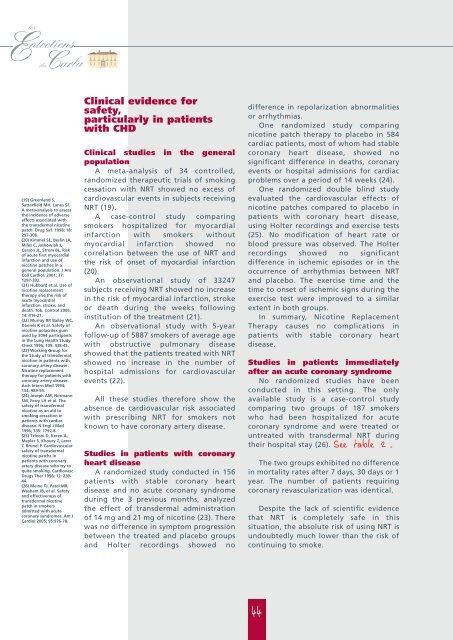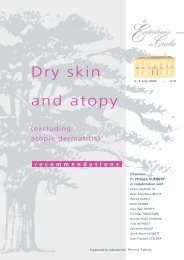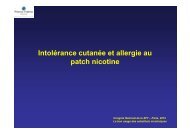Nicotine replacement therapy … - Carlos A ... - Entretiens du Carla
Nicotine replacement therapy … - Carlos A ... - Entretiens du Carla
Nicotine replacement therapy … - Carlos A ... - Entretiens du Carla
You also want an ePaper? Increase the reach of your titles
YUMPU automatically turns print PDFs into web optimized ePapers that Google loves.
(19) Greenland S,<br />
Satterfield MH, Lanes SF.<br />
A meta-analysis to assess<br />
the incidence of adverse<br />
effects associated with<br />
the transdermal nicotine<br />
patch. Drug Saf. 1998; 18:<br />
297-308.<br />
(20) Kimmel SE, Berlin JA,<br />
Miles C, Jaskowiak J,<br />
Carson JL, Strom BL. Risk<br />
of acute first myocardial<br />
infarction and use of<br />
nicotine patches in a<br />
general population. J Am<br />
Coll Cardiol. 2001; 37:<br />
1297-302.<br />
(21) Hubbard et al. Use of<br />
nicotine <strong>replacement</strong><br />
<strong>therapy</strong> and the risk of<br />
acute myocardial<br />
infarction, stroke, and<br />
death. Tob. Control 2005;<br />
14; 416-21.<br />
(22) Murray RP, Bailey WC,<br />
Daniels K et al. Safety of<br />
nicotine polacrilex gum<br />
used by 3094 participants<br />
in the Lung Health Study.<br />
Chest 1996; 109: 438-45.<br />
(23) Working Group for<br />
the Study of transdermal<br />
nicotine in patients with<br />
coronary artery disease.<br />
<strong>Nicotine</strong> <strong>replacement</strong><br />
<strong>therapy</strong> for patients with<br />
coronary artery disease.<br />
Arch Intern Med 1994;<br />
154: 989-95.<br />
(24) Joseph AM, Normann<br />
SM, Ferry LH et al. The<br />
safety of transdermal<br />
nicotine as an aid to<br />
smoking cessation in<br />
patients with cardiac<br />
disease. N Engl J Med<br />
1996; 335: 1792-8.<br />
(25) Tzivoni D, Keren A,<br />
Meyler S, Khoury Z, Lerer<br />
T, Brunel P. Cardiovascular<br />
safety of transdermal<br />
nicotine patchs in<br />
patients with coronary<br />
artery disease who try to<br />
quite smoking. Cardiovasc<br />
Drugs Ther 1998; 12: 239-<br />
44.<br />
(26) Meine TJ, Patel MR,<br />
Washam JB, et al. Safety<br />
and effectiveness of<br />
transdermal nicotine<br />
patch in smokers<br />
admitted with acute<br />
coronary syndromes. Am J<br />
Cardiol 2005; 95:976-78.<br />
Clinical evidence for<br />
safety,<br />
particularly in patients<br />
with CHD<br />
Clinical studies in the general<br />
population<br />
A meta-analysis of 34 controlled,<br />
randomized therapeutic trials of smoking<br />
cessation with NRT showed no excess of<br />
cardiovascular events in subjects receiving<br />
NRT (19).<br />
A case-control study comparing<br />
smokers hospitalized for myocardial<br />
infarction with smokers without<br />
myocardial infarction showed no<br />
correlation between the use of NRT and<br />
the risk of onset of myocardial infarction<br />
(20).<br />
An observational study of 33247<br />
subjects receiving NRT showed no increase<br />
in the risk of myocardial infarction, stroke<br />
or death <strong>du</strong>ring the weeks following<br />
institution of the treatment (21).<br />
An observational study with 5-year<br />
follow-up of 5887 smokers of average age<br />
with obstructive pulmonary disease<br />
showed that the patients treated with NRT<br />
showed no increase in the number of<br />
hospital admissions for cardiovascular<br />
events (22).<br />
All these studies therefore show the<br />
absence de cardiovascular risk associated<br />
with prescribing NRT for smokers not<br />
known to have coronary artery disease.<br />
Studies in patients with coronary<br />
heart disease<br />
A randomized study con<strong>du</strong>cted in 156<br />
patients with stable coronary heart<br />
disease and no acute coronary syndrome<br />
<strong>du</strong>ring the 3 previous months, analyzed<br />
the effect of transdermal administration<br />
of 14 mg and 21 mg of nicotine (23). There<br />
was no difference in symptom progression<br />
between the treated and placebo groups<br />
and Holter recordings showed no<br />
difference in repolarization abnormalities<br />
or arrhythmias.<br />
One randomized study comparing<br />
nicotine patch <strong>therapy</strong> to placebo in 584<br />
cardiac patients, most of whom had stable<br />
coronary heart disease, showed no<br />
significant difference in deaths, coronary<br />
events or hospital admissions for cardiac<br />
problems over a period of 14 weeks (24).<br />
One randomized double blind study<br />
evaluated the cardiovascular effects of<br />
nicotine patches compared to placebo in<br />
patients with coronary heart disease,<br />
using Holter recordings and exercise tests<br />
(25). No modification of heart rate or<br />
blood pressure was observed. The Holter<br />
recordings showed no significant<br />
difference in ischemic episodes or in the<br />
occurrence of arrhythmias between NRT<br />
and placebo. The exercise time and the<br />
time to onset of ischemic signs <strong>du</strong>ring the<br />
exercise test were improved to a similar<br />
extent in both groups.<br />
In summary, <strong>Nicotine</strong> Replacement<br />
Therapy causes no complications in<br />
patients with stable coronary heart<br />
disease.<br />
Studies in patients immediately<br />
after an acute coronary syndrome<br />
No randomized studies have been<br />
con<strong>du</strong>cted in this setting. The only<br />
available study is a case-control study<br />
comparing two groups of 187 smokers<br />
who had been hospitalized for acute<br />
coronary syndrome and were treated or<br />
untreated with transdermal NRT <strong>du</strong>ring<br />
their hospital stay (26). See table 2.<br />
The two groups exhibited no difference<br />
in mortality rates after 7 days, 30 days or 1<br />
year. The number of patients requiring<br />
coronary revascularization was identical.<br />
Despite the lack of scientific evidence<br />
that NRT is completely safe in this<br />
situation, the absolute risk of using NRT is<br />
undoubtedly much lower than the risk of<br />
continuing to smoke.<br />
44






